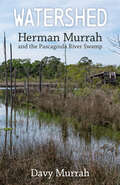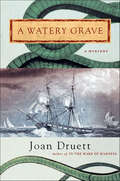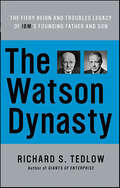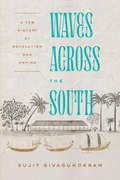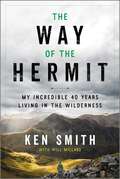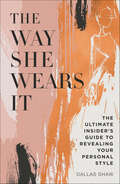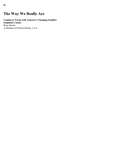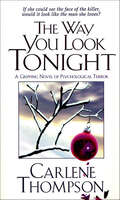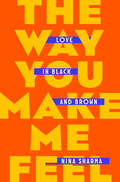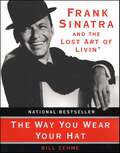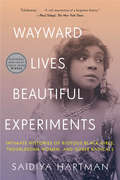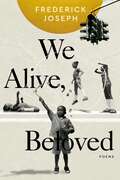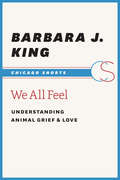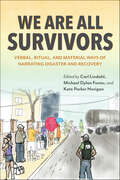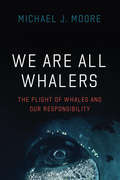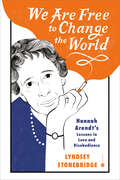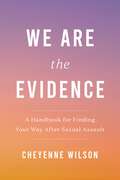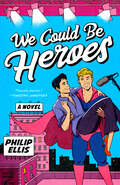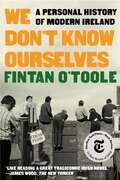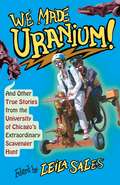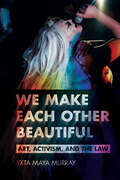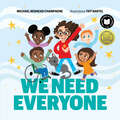- Table View
- List View
Watershed: Herman Murrah and the Pascagoula River Swamp
by Davy MurrahThe Pascagoula River is the largest unobstructed river in the contiguous United States. Because of this lack of restraint, the river has been left to rise and fall naturally with the seasons, overflowing annually into the adjoining bottomland forest. This phenomenon makes the Pascagoula River one of the wildest rivers, surrounded by some of the most ecologically diverse woodlands, in North America.Herman Murrah (1935–2002) lived his entire life on the banks and in the swamp surrounding this river in southeast Mississippi. Watershed: Herman Murrah and the Pascagoula River Swamp recounts pivotal moments in Herman’s life and in Mississippi’s conservation history more broadly. In this book, Herman’s eldest son, Davy, details the adventures that continue to inspire young conservationists in the fight to protect our remaining natural ecosystems.As a young adult, Herman worked as a game warden in the Pascagoula River Swamp. When the Pascagoula Hardwood Company, then owners of the swamp, decided to sell the vast tract of forest for clearcutting, Herman was incensed. Determined to protect this natural wonder, Herman teamed up with other visionaries to persuade the State of Mississippi to purchase the land and preserve it in perpetuity to the benefit of future generations of humans and wildlife alike. Eventually, the state agreed and finalized the purchase. Herman was appointed area manager for the upper portion of the newly designated Pascagoula River Wildlife Management Area. He dedicated the remainder of his life to preserving, protecting, and improving the swamp for the good of south Mississippi.
A Watery Grave: A Mystery (Wiki Coffin Mysteries #1)
by Joan DruettThe year is 1838, and after more than ten years in the planning, the famous United States Exploring Expedition is set to launch into uncharted waters from the coast of Virginia. A convoy of seven ships filled with astronomers, mapmakers, naturalists, and the sailors charged with getting them around the world, the "Ex. Ex." is finally underway, with much fanfare.Aboard the convoy as ship's linguist is Wiki Coffin. Half New Zealand Maori and half American, Wiki speaks numerous languages and is expected to help the crew navigate the Pacific islands that are his native heritage. But just before departure Wiki, subject to the unfortunate bigotry of the time, is arrested for a vicious murder he didn't commit.The convoy sails off, but just before the ships are out of reach Wiki is exonerated, set free to catch up with his ship and sail on. The catch: the local sheriff is convinced that the real murderer is aboard one of the seven ships of the expedition, and Wiki is deputized to identify the killer and bring him to justice. Full of the evocative maritime detail and atmosphere that have won her numerous awards for her nonfiction, Joan Druett's A Watery Grave is the mystery debut of a masterful maritime writer.
Watery Planet: How a water crisis is impacting our world
by Anna ClaybourneWatery Planet offers young readers a clear, insightful look at Earth's ongoing water challenges.Water makes our life on Earth possible. We need water not just to drink and keep clean, but also for agriculture, industry, transport and much, much more. But despite having an enormous amount of water on Earth, only 1 per cent of it is available for us to use and it's at increasing risk.Watery Planet looks at the reasons behind our looming water crisis - from uneven distribution to water wastage, pollution and climate change. It explores how floods, droughts and rising sea levels are becoming a stark reality as the world warms and describes how we are adapting to these challenges. It also looks at some positive, practical solutions to our water problems and explains how we can all do our part to help save Earth's most precious resource.Contents:A WHOLE WORLD OF WATER WE ALL NEED WATER! HOW WE GET WATER IS THERE ENOUGH WATER? WATER AND HEALTH CASE STUDY: COLLECTING WATER IN ETHIOPIA WATER POLLUTION WATER AND GLOBAL WARMING FLOODS AND DROUGHTS CASE STUDY: PAKISTAN FLOODS RISING SEA LEVELS WATER AND NATURE WATER AND WILDLIFE CASE STUDY: THIRSTY AVOCADOS DOING THINGS DIFFERENTLY WATER FOR THE WORLD CASE STUDY: THE ARAL SEA WATERY HOMES WHAT CAN YOU DO? THE FUTURE OF WATER GLOSSARY FURTHER READING INDEX Titles in this series:Plastic PlanetHot PlanetRecycled PlanetSustainable PlanetExtinction PlanetPeaceful Planet?Unequal Planet
The Watson Dynasty: The Fiery Reign and Troubled Legacy of IBM's Founding Father and Son
by Richard S. TedlowFor an extraordinary fifty-seven-year period, one of the nation's largest and fastest-growing companies was run by two men who were flesh and blood. The chief executives of the International Business Machines Corporation from 1914 until 1971 were Thomas J. Watson and Thomas J. Watson, father and son. That great corporation bears the imprint of both men -- their ambitions and their strengths -- but it also bears the consequences of a family that was in near-constant conflict.Sometimes wrong but never in doubt, both Watsons had clear -- and farsighted -- visions of what their company could become. They also had volcanic tempers. Their fights with each other combined with their commitment to leadership and excellence made IBM one of the most rewarding, yet gut-clutching firms to work for in the history of American business.We are accustomed to describing professional behavior as if men and women leave their emotions and vulnerabilities at home each day. In the case of the Watsons, filial and sibling strife could not be excluded from the office. In closely studying the desires and frustrations of the Watson family, eminent historian Richard S. Tedlow has produced something more than a family portrait or a company history. He has raised the nearly forbidden issue of the role of emotion in corporate life.This book explores the interplay between the person- alities of these two extraordinary men and the firm they created. Both Watsons had deeply held beliefs about what a corporation is and should be. These ideas helped make "Big Blue" the bluest of blue-chip stocks during the Watsons' tenure. These very beliefs, however, also sowed the seeds for IBM's disasters in the late 1980s and early 1990s, when the company had lost sight of the original meaning behind many of the practices each man put into place.Tracing the family's idiosyncratic ability to cope with each other's weaknesses but not their strengths, The Watson Dynasty is a book for every person who ever went to work but didn't want to check his personality at the door.
Waves Across the South: A New History of Revolution and Empire
by Sujit SivasundaramThis is a story of tides and coastlines, winds and waves, islands and beaches. It is also a retelling of indigenous creativity, agency, and resistance in the face of unprecedented globalization and violence. Waves Across the South shifts the narrative of the Age of Revolutions and the origins of the British Empire; it foregrounds a vast southern zone that ranges from the Arabian Sea and southwest Indian Ocean across to the Bay of Bengal, and onward to the South Pacific and the Tasman Sea. As the empires of the Dutch, French, and especially the British reached across these regions, they faced a surge of revolutionary sentiment. Long-standing venerable Eurasian empires, established patterns of trade and commerce, and indigenous practice also served as a context for this transformative era. In addition to bringing long-ignored people and events to the fore, Sujit Sivasundaram opens the door to new and necessary conversations about environmental history, the consequences of historical violence, the legacies of empire, the extraction of resources, and the indigenous futures that Western imperialism cut short. The result is nothing less than a bold new way of understanding our global past, one that also helps us think afresh about our shared future.
The Way Forward (Mockingbird Bridge #1)
by Eliana WestThe small town he couldn&’t wait to leave is calling him home… Dax Ellis returns to Colton, Mississippi, a changed man. He traveled the world, earned a fortune, and made a lifetime of memories, but now he longs to put down roots. Time hasn&’t been kind to his hometown, and Dax wants to help—if only he can convince everyone he&’s not the same petulant boy he used to be. Especially the one woman who has every reason not to trust him. Librarian Callie Colton cherished summers with her grandparents, in the town her ancestors helped build, in spite of the boy who called her names. Now that Colton is her home, life is quiet until Dax returns…and, along with him, threatening letters on her doorstep. He may still have the power to hurt her, but she&’s not the same scared little girl she used to be. But as the danger escalates, Dax will have to face his past to find a way forward for the relationship they were cheated of once before.
The Way of the Hermit: My Incredible 40 Years Living in the Wilderness
by Ken SmithSubconsciously, I pressed myself into the loch's banks as that summer inched forward. We'd got off to a rocky beginning, but I started to see Treig in a different way. There was something about this land that told me just to hold on a while longer. It might've been just a whisper at the time, but I knew it was definitely worth heeding. I just knew that was it. This was the place.Seventy-four-year-old Ken Smith has spent the past four decades in the Scottish Highlands. His home is a log cabin nestled near Loch Treig, known as "the lonely loch," where he lives off the land. He fishes for his supper, chops his own wood and even brews his own tipple. He is, in the truest sense of the word, a hermit.From his working-class origins in Derbyshire, Ken always sensed that there was more ot life than an empty nine to five. Then one day in 1974, an attack from a group of drunken men left him for dead. Determined to change his prospects, Ken quit his job and spent his formative years traveling in the Yukon. It was here, in the vast wilderness of northwestern Canada, that he honed his survival skills and grew closer to nature. Returning to Britain, he continued his nomadic lifestyle, wandering north and living in huts until he finally reached Loch Treig. Ken decided to lay his roots amongst the dense woodland and Highland air, and has lived there ever since.In The Way of the Hermit, Ken shares the remarkable story of his lfe for the very first time. Told with humor and compassion, his unique insights allow us to glimpse the awe and wonder of a life lived in nature and offer wisdom on how each of us can escape the pressures and stresses of modern life.
The Way She Wears It: The Ultimate Insider's Guide to Revealing Your Personal Style
by Dallas ShawYou are your own brand. But to market yourself well, you need the best package, and that’s your own authentic style. In The Way She Wears It, fashion illustrator and It girl Dallas Shaw shows you how to mix up your closet and shop like a rock star.The most highly sought-after fashion illustrator/luxury project designer working today uses her sketches, styling skills and visual expertise to help you develop your eye, define your aesthetic, banish the predictable, stock your wardrobe, and make heads turn in this highly visual and lavishly designed & illustrated personal fashion guide.Working backstage, in showrooms, and alongside creative directors and iconic designers, Dallas learned from the best. In this sophisticated, illustrated handbook, this go-to girl for clients ranging from Chanel, Donna Karan, Oscar de la Renta, Kate Spade, Christian Louboutin, and Ralph Lauren to Anthropologie, Target, Maybelline, and Neutrogena shares her insider tricks—expert layering hacks, the secrets to print pairing, bold color choices—and something you won’t find off the rack: confidence.Organized around a range of challenges, this lookbook-meets workbook-is a must for every woman, whether you’re a fashion novice trying to figure out your signature style, a fashionista who wants to step up her game, or the most stylish presence in the room looking to stay ahead of the competition. Mixing breathtaking creative visuals—hundreds of photos and drawings, including 100 original pieces of art—and a little bit of girl talk,Dallas teaches every woman how to banish the predictable and develop and maintain their own unique look. She also busts fashion myths, serves up insider industry tricks and expert picks, and most important, inspires you to live beautifully.
The Way We Really Are: Coming To Terms With America's Changing Families
by Stephanie CoontzStephanie Coontz, the author of The Way We Never Were, now turns her attention to the mythology that surrounds today's family--the demonizing of "untraditional" family forms and marriage and parenting issues. She argues that while it's not crazy to miss the more hopeful economic trends of the 1950s and 1960s, few would want to go back to the gender roles and race relations of those years. Mothers are going to remain in the workforce, family diversity is here to stay, and the nuclear family can no longer handle all the responsibilities of elder care and childrearing.Coontz gives a balanced account of how these changes affect families, both positively and negatively, but she rejects the notion that the new diversity is a sentence of doom. Every family has distinctive resources and special vulnerabilities, and there are ways to help each one build on its strengths and minimize its weaknesses.The book provides a meticulously researched, balanced account showing why a historically informed perspective on family life can be as much help to people in sorting through family issues as going into therapy--and much more help than listening to today's political debates.
The Way You Look Tonight: A Gripping Novel of Psychological Terror
by Carlene ThompsonFor Better...Deborah Robinson lived on a quiet street in a small town with her handsome husband and darling twins. It was the picture-perfect life---until the day Deborah's husband vanished without a trace.Or For Worse...Before he disappeared, Steve had been on edge. When he told her he was distracted by work, Deborah is scared. She's heard about the sadistic murders of several local women, and she can't shake the horrible feeling that the killings are somehow connected to Steve's disappearance.Until Death Do Us Part...Torn by guilt, tormented by suspiciou, Deborah begins to delve into the shadowy secrets of her husband's past. What she finds will chill her to the bone. Dor Deborah no longer knows who or what her husband was. But she does know that someone is watching the Robinson house, someone who has ruthlessly killed---and is only waiting for the perfect moment to stike again...
The Way You Make Me Feel: Love in Black and Brown
by Nina Sharma&“Remarkable . . . The Way You Make Me Feel affirms that Black and Brown existence in America comes with no guarantee of collective solidarity, no innate promise of racial equality. The path to justice is uncertain, Sharma reminds us, and we must each work hard—and be bold enough to sacrifice our own comfort—to actualize it.&” —Washington PostA hilarious and moving memoir in essays about love and allyship, told through one Asian and Black interracial relationshipWhen Nina Sharma meets Quincy while hitching a ride to a friend&’s Fourth of July barbecue, she spots a favorite book, Maxine Hong Kingston&’s The Woman Warrior, in the back seat of his cramped car, and senses a sadness from him that&’s all too familiar to her. She is immediately intrigued—who is this man? In The Way You Make Me Feel, Sharma chronicles her and Quincy&’s love story, and in doing so, examines how their Black and Asian relationship becomes the lens through which she moves through and understands the world.In a series of sensual and sparkling essays, Sharma reckons with caste, race, colorism, and mental health, moving from her seemingly idyllic suburban childhood through her and Quincy&’s early sweeping romance in the so-called postracial Obama years and onward to their marriage. Growing up, she hears her parents talk about the racism they experienced at the hands of white America—and as an adult, she confronts the complexities of American racism and the paradox of her family&’s disappointment when she starts dating a Black man. While watching The Walking Dead, Sharma dives into the eerie parallels between the brutal death of Steven Yeun&’s character and the murder of Vincent Chin. She examines the trailblazing Mira Nair film Mississippi Masala, revolutionary in its time for depicting a love story between an Indian woman and a Black man on screen, and considers why interracial relationships are so often assumed to include white people. And as she and Quincy decide whether to start a family, they imagine a universe in which Vice President Kamala Harris could possibly be their time-traveling daughter.Written with a keen critical eye and seamlessly weaving in history, pop culture, and politics, The Way You Make Me Feel reaffirms the idea that allyship is an act of true love.
The Way You Wear Your Hat: Frank Sinatra and the Lost Art of Livin'
by Bill ZehmeIn The Way You Wear Your Hat, author Bill Zehme presents a masterful assembly of the most personal details and gorgeous minutiae of Frank Sinatra's way of livingmatters of the heart and heartbreak, friendship and leadership, drinking and cavorting, brawling and wooing, tuxedos and snap-brimsall crafted from rare interviews with Sinatra himself as well as many other intimates, including Tony Bennett, Don Rickles, Angie Dickinson, Tony Curtis, and Robert Wagner, in addition to daughters Nancy and Tina Sinatra. Capturing the timeless romance and classic style of the fifties and the loose sixties, The Way You Wear Your Hat is a stunning exploration of the Sinatra mystique.
Wayward Lives, Beautiful Experiments: Intimate Histories Of Social Upheaval
by Saidiya HartmanWinner of the 2019 National Book Critics Circle Award in Criticism Winner of the PEN/John Kenneth Galbraith Award for Nonfiction Winner of the 2020 Judy Grahn Award for Lesbian Nonfiction Finalist for the Lambda Literary Award for Lesbian Memoir/Biography "Exhilarating…A rich resurrection of a forgotten history." —Parul Sehgal, New York Times Beautifully written and deeply researched, Wayward Lives, Beautiful Experiments examines the revolution of black intimate life that unfolded in Philadelphia and New York at the beginning of the twentieth century. In wrestling with the question of what a free life is, many young black women created forms of intimacy and kinship indifferent to the dictates of respectability and outside the bounds of law. They cleaved to and cast off lovers, exchanged sex to subsist, and revised the meaning of marriage. Longing and desire fueled their experiments in how to live. They refused to labor like slaves or to accept degrading conditions of work. Here, for the first time, these women are credited with shaping a cultural movement that transformed the urban landscape. Through a melding of history and literary imagination, Wayward Lives, Beautiful Experiments recovers these women’s radical aspirations and insurgent desires.
We Alive, Beloved
by Frederick JosephNYT Bestselling Author, Frederick Joseph, explores a new genre in this captivating poetry collection that seeks to find joy in moments of difficulty whether through illuminating the beauty of being Black, highlighting the hope that can be found in childhood, or by sharing intimate truths revealed on a mental health journey. This book will appeal to both new and established readers of poetry.Step into the world of We Alive, Beloved, where its words will resonate within the deepest corners of your soul, leaving a mark on your heart and a renewed appreciation for the beauty of being alive. We Alive, Beloved moves beyond being a poetry collection; it's a celebration of the profound aspects of our existence. Each poem seeks to immortalize the fleeting moments of joy, love, resilience, and inspiration that often slip through the grasp of our fast-paced lives. In this poetic testament, we defy the ephemeral nature of beauty and goodness, daring to clutch onto these facets of life for just a little longer. With words that stand as guardians against the relentless march of time and the ceaseless tides of change, trauma, and grief, this collection becomes a sanctuary of light in a world that sometimes seems dim. We Alive, Beloved explores a rich tapestry of themes, from the intricacies of relationships and the heartache of loss, to the wide-eyed wonder of existence and the challenges of exploring the possibility of parenthood in our modern age. Each poem reaches out to readers, offering a mirror to their own journeys and emotions, inviting them to be seen and acknowledged in its lyrical embrace.
We All Feel: Understanding Animal Grief & Love (Chicago Shorts)
by Barbara J. KingFrom the time of our earliest childhood encounters with animals, we casually ascribe familiar emotions to them, though scientists have long cautioned against such anthropomorphizing. Recently, however, things have begun to shift in the other direction, and anthropologist Barbara J. King is at the forefront of that movement, arguing strenuously that we can—and should—attend to animal emotions. In the stories she tells here, King relays how some farm animals—horses, goats, chickens, and ducks—bond with others and engage in mourning when their friends die. Here, too, dolphins and whales exhibit striking signs of suffering over the loss of babies and companions: a mother dolphin will not give up her dead baby, and whales risk stranding themselves in small groups rather than abandon kin. As part of a larger web of life, death, love, and loss, King calls our attention to emotions—both our own and those of our companion species.
We Are All Survivors: Verbal, Ritual, and Material Ways of Narrating Disaster and Recovery
by Carl Lindahl, Michael Dylan Foster and Kate Parker HoriganWhat is the role of folklore in the discussion of catastrophe and trauma? How do disaster survivors use language, ritual, and the material world to articulate their experiences? What insights and tools can the field of folkloristics offer survivors for navigating and narrating disaster and its aftermath? Can folklorists contribute to broader understandings of empathy and the roles of listening in ethnographic work?We Are All Survivors is a collection of essays exploring the role of folklore in the wake of disaster. Contributors include scholars from the United States and Japan who have long worked with disaster-stricken communities or are disaster survivors themselves; individual chapters address Hurricane Katrina, Hurricane Maria, and two earthquakes in Japan, including the earthquake, tsunami, and nuclear disaster of 2011. Adapted from a 2017 special issue of Fabula (from the International Society for Folk Narrative Research), the book includes a revised introduction, an additional chapter with original illustrations, and a new conclusion considering how folklorists are documenting the COVID-19 pandemic.We Are All Survivors bears witness to survivors' expressions of remembrance, grieving, and healing.
We Are All Whalers: The Plight of Whales and Our Responsibility
by Michael J. MooreRelating his experiences caring for endangered whales, a veterinarian and marine scientist shows we can all share in the salvation of these imperiled animals.The image most of us have of whalers includes harpoons and intentional trauma. Yet eating commercially caught seafood leads to whales’ entanglement and slow death in rope and nets, and the global shipping routes that bring us readily available goods often lead to death by collision. We—all of us—are whalers, marine scientist and veterinarian Michael J. Moore contends. But we do not have to be.Drawing on over forty years of fieldwork with humpback, pilot, fin, and, in particular, North Atlantic right whales—a species whose population has declined more than 20 percent since 2017—Moore takes us with him as he performs whale necropsies on animals stranded on beaches, in his independent research alongside whalers using explosive harpoons, and as he tracks injured whales to deliver sedatives. The whales’ plight is a complex, confounding, and disturbing one. We learn of existing but poorly enforced conservation laws and of perennial (and often failed) efforts to balance the push for fisheries profit versus the protection of endangered species caught by accident.But despite these challenges, Moore’s tale is an optimistic one. He shows us how technologies for ropeless fishing and the acoustic tracking of whale migrations make a dramatic difference. And he looks ahead with hope as our growing understanding of these extraordinary creatures fuels an ever-stronger drive for change.For more information on Moore’s book and research, please visit his webpage at the Woods Hole Oceanographic Institution.
We Are Free to Change the World: Hannah Arendt's Lessons in Love and Disobedience
by Lyndsey StonebridgeA timely guide on how to live—and think—through the challenges of our century drawn from the life and thought of political theorist Hannah Arendt, one of the twentieth century&’s foremost opponents of totalitarianism&“We are free to change the world and to start something new in it.&”—Hannah ArendtThe violent unease of today&’s world would have been familiar to Hannah Arendt. Tyranny, occupation, disenchantment, post-truth politics, conspiracy theories, racism, mass migration: She lived through them all.Born in the first decade of the last century, she escaped fascist Europe to make a new life for herself in America, where she became one of its most influential—and controversial—public intellectuals. She wrote about power and terror, exile and love, and above all, about freedom. Questioning—thinking—was her first defense against tyranny. She advocated a politics of action and plurality, courage and, when necessary, disobedience.We Are Free to Change the World is a book about the Arendt we need for the twenty-first century. It tells us how and why Arendt came to think the way she did, and how to think when our own politics goes off the rails. Both a guide to Arendt&’s life and work, and its dialogue with our troubled present, We Are Free to Change the World is an urgent call for us to think, as Hannah Arendt did—unflinchingly, lovingly, and defiantly—through our own unpredictable times.
We Are the Evidence: A Handbook for Finding Your Way After Sexual Assault
by Cheyenne WilsonA necessary, reassuring guide for all sexual assault survivors in need of immediate emotional and legal support post assault, and in the months and years after.We Are the Evidence is the first comprehensive resource for survivors of sexual assault. Written with conviction and compassion by Cheyenne Wilson, a registered nurse and survivor of sexual assault, this handbook contains everything victims and advocates need to know to navigate the tumultuous times that follow an assault. Within, there's advice for: The appropriate steps to take immediately after an assault Disclosing your assault how and when you choose How to pursue justice and navigate the legal system Beginning the healing process and reclaiming your power Throughout, you'll find exercises, opportunities to rest, and invaluable guidance from experts like attorneys, detectives and therapists. Voices from other sexual assault survivors also lend their support. Meant to be easily accessible, everything is organized for you to go right to the topic you most need guidance for, no matter where you are on your healing journey. You deserve to be heard, believed, and supported.
We Came Here to Shine: A Novel
by Susie Orman SchnallSet at the iconic 1939 New York World’s Fair, Susie Orman Schnall's We Came Here to Shine is historical fiction featuring two bold and ambitious women who navigate a world of possibility and find out what they're truly made of during a glorious summer of spectacle and potential.“An ode to female friendship that pulses with momentum and left me breathless.” —Fiona Davis, national bestselling author of The Chelsea Girls“A remarkable novel about the challenges women face and the courage they must summon in order to lead the lives they deserve." —Lynda Cohen Loigman, author of The Two-Family HouseGorgeous Vivi is the star of the Aquacade synchronized swimming spectacular and plucky Max is a journalist for the fair's daily paper. Both are striving to make their way in a world where men try to control their actions and where secrets are closely kept. But when Vivi and Max become friends and their personal and professional prospects are put in jeopardy, they team up to help each other succeed and to realize their dreams during the most meaningful summer of their lives. Perfect for fans of Taylor Jenkins Reid and Beatriz Williams, We Came Here to Shine is a story of ambition, friendship, and persistence with a fascinating behind-the-scenes look at the extraordinary NY World's Fair.
We Could Be Heroes
by Philip EllisNot all heroes wear capes. Some wear high heels and a wig.Patrick's acting career is on the rise, and the superhero movie he's filming might put him on the map . . . if the endless reshoots ever stop. Meanwhile, Will, a secondhand bookseller and part-time drag queen, is just trying to live his best life. After a chance encounter on a particularly chaotic night, a curious friendship sparks between the two men.At least, that&’s what they tell each other. Sure, Patrick finds Will captivatingly hilarious, and Will can&’t help but keep thinking about who is really behind the perfect mask Patrick shows the rest of the world, but nothing could ever really happen, right? Superheroes don&’t date drag queens, after all.When reality crashes into the fantasy world they&’ve built together, Will has to make a choice between the man of his dreams and being true to himself. Can Patrick be the hero Will&’s been waiting for, or will Will be the one to save Patrick after all? Uproarious and touching, We Could Be Heroes is an ode to queer joy and a romance that just might save the world.
We Don't Know Ourselves: A Personal History of Modern Ireland
by Fintan O'TooleNEW YORK TIMES BESTSELLER NEW YORK TIMES • 10 BEST BOOKS OF THE YEAR NATIONAL BESTSELLER The Atlantic: 10 Best Books of 2022 Best Books of the Year: Washington Post, New Yorker, Salon, Foreign Affairs, New Statesman, Chicago Public Library, Vroman's “[L]ike reading a great tragicomic Irish novel.” —James Wood, The New Yorker “Masterful . . . astonishing.” —Cullen Murphy, The Atlantic "A landmark history . . . Leavened by the brilliance of O'Toole's insights and wit.” —Claire Messud, Harper’s Winner • 2021 An Post Irish Book Award — Nonfiction Book of the Year • from the judges: “The most remarkable Irish nonfiction book I’ve read in the last 10 years”; “[A] book for the ages.” A celebrated Irish writer’s magisterial, brilliantly insightful chronicle of the wrenching transformations that dragged his homeland into the modern world. Fintan O’Toole was born in the year the revolution began. It was 1958, and the Irish government—in despair, because all the young people were leaving—opened the country to foreign investment and popular culture. So began a decades-long, ongoing experiment with Irish national identity. In We Don’t Know Ourselves, O’Toole, one of the Anglophone world’s most consummate stylists, weaves his own experiences into Irish social, cultural, and economic change, showing how Ireland, in just one lifetime, has gone from a reactionary “backwater” to an almost totally open society—perhaps the most astonishing national transformation in modern history. Born to a working-class family in the Dublin suburbs, O’Toole served as an altar boy and attended a Christian Brothers school, much as his forebears did. He was enthralled by American Westerns suddenly appearing on Irish television, which were not that far from his own experience, given that Ireland’s main export was beef and it was still not unknown for herds of cattle to clatter down Dublin’s streets. Yet the Westerns were a sign of what was to come. O’Toole narrates the once unthinkable collapse of the all-powerful Catholic Church, brought down by scandal and by the activism of ordinary Irish, women in particular. He relates the horrific violence of the Troubles in Northern Ireland, which led most Irish to reject violent nationalism. In O’Toole’s telling, America became a lodestar, from John F. Kennedy’s 1963 visit, when the soon-to-be martyred American president was welcomed as a native son, to the emergence of the Irish technology sector in the late 1990s, driven by American corporations, which set Ireland on the path toward particular disaster during the 2008 financial crisis. A remarkably compassionate yet exacting observer, O’Toole in coruscating prose captures the peculiar Irish habit of “deliberate unknowing,” which allowed myths of national greatness to persist even as the foundations were crumbling. Forty years in the making, We Don’t Know Ourselves is a landmark work, a memoir and a national history that ultimately reveals how the two modes are entwined for all of us.
We Made Uranium!: And Other True Stories from the University of Chicago's Extraordinary Scavenger Hunt
by Leila SalesItem #176: A fire drill. No, not an exercise in which occupants of a building practice leaving the building safely. A drill which safely emits a bit of fire, the approximate shape and size of a drill bit. Item #74: Enter a lecture class in street clothes. Receive loud phone call. Shout “I NEED TO GO, THE CITY NEEDS ME!” Remove street clothes to reveal superhero apparel. Run out for the good of the land. Item #293: Hypnotizing a chicken seems easy, but if the Wikipedia article on the practice is to be believed, debate on the optimal method is heated. Do some trials on a real chicken and submit a report . . . for science of course. Item #234: A walking, working, people-powered but preferably wind-powered Strandbeest. Item #188: Fattest cat. Points per pound. The University of Chicago’s annual Scavenger Hunt (or “Scav”) is one of the most storied college traditions in America. Every year, teams of hundreds of competitors scramble over four days to complete roughly 350 challenges. The tasks range from moments of silliness to 1,000-mile road trips, and they call on participants to fully embrace the absurd. For students it is a rite of passage, and for the surrounding community it is a chance to glimpse the lighter side of a notoriously serious university.We Made Uranium! shares the stories behind Scav, told by participants and judges from the hunt’s more than thirty-year history. The twenty-three essays range from the shockingly successful (a genuine, if minuscule, nuclear reaction created in a dorm room) to the endearing failures (it’s hard to build a carwash for a train), and all the chicken hypnotisms and permanent tattoos in between. Taken together, they show how a scavenger hunt once meant for blowing off steam before finals has grown into one of the most outrageous annual traditions at any university. The tales told here are absurd, uplifting, hilarious, and thought-provoking—and they are all one hundred percent true.
We Make Each Other Beautiful: Art, Activism, and the Law (Publicly Engaged Scholars: Identities, Purposes, Practices)
by Yxta Maya MurrayWe Make Each Other Beautiful focuses on woman of color and queer of color artists and artist collectives who engage in direct political action as a part of their art practice. Defined by public protest, rule-breaking, rebellion, and resistance to governmental and institutional abuse, direct-action "artivism" draws on the aims, radical spirit, and tactics of the civil rights and feminist movements and on the struggles for disability rights, queer rights, and immigrant rights to seek legal and social change. Yxta Maya Murray traces the development of artivism as a practice from the Harlem Renaissance to Yoko Ono, Judy Baca, and Marsha P. Johnson. She also studies its role in transforming law and society. We Make Each Other Beautiful profiles the work and lives of four contemporary artivists —Carrie Mae Weems, Young Joon Kwak, Tanya Aguiñiga, and Imani Jacqueline Brown—and the artivist collective Drawn Together, combining new oral histories with sharp analyses of how their diverse and expansive artistic practices bear important aesthetic and politicolegal meanings that address a wide range of injustices.
We Need Everyone
by Michael Redhead ChampagneEveryone has a gift. Every gift is different, and every gift is special. Our world needs you to share your gift.What is your gift? How can you use your gift to help others?We Need Everyone empowers children to identify their gifts and use them to overcome challenges, achieve goals, and strengthen communities. Inspiring and uplifting, this interactive picture book celebrates diverse cultures, perspectives, and abilities through playful illustrations. Perfect for reading aloud.
